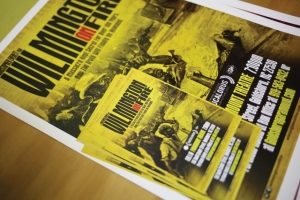'Wilmington on Fire' to play at Paramount
By John Joyce
Published in News on January 27, 2016 1:46 PM

News-Argus/CASEY MOZINGO
'Wilmington on Fire' director Christopher Everette and Kent Chatfield, one of the film's stars, take a moment to laugh while discussing the documentary about violence that broke out in Wilmington in 1898. The movie will show for one night only at the Paramount Theatre this coming Monday.

News-Argus/CASEY MOZINGO
Filmmaker Christopher Everette is traveling around the Goldsboro and Wayne County area hanging posters and passing out cards promoting his movie 'Wilmington on Fire' that will show in the Paramount Theatre this coming Monday night.
No official body count exists.
Estimates reported at the time range from 10 to 25.
But historians say as many as a hundred or more were killed.
A documentary depicting the violence that broke out Nov. 10, 1898, in Wilmington -- later to become known as the Wilmington Race Riot of 1898 -- is coming to Goldsboro on Feb. 1.
Filmmaker Christopher Everette, 33, of Laurinburg, said there was no riot.
"It was a massacre," he said.
The event is widely considered the catalyst that ushered in the Jim Crow era in North Carolina segregation laws backed up by brute vigilantism quickly spread throughout the South and would remain in effect until the Civil Rights Act of 1964, Everette said.
"Wilmington on Fire," written and directed by Everette, will be shown Monday at 7 p.m. at the Paramount Theatre in Goldsboro. A panel discussion with Everette and a pair of historians who contributed to the film will follow.
"We back everything up with fact," Everette said.
Everette received his degree in graphic arts from King's College in Charlotte. An actor and short-film maker, Everette said he became interested in the 1898 event after hearing it talked about among friends. He began looking into it more and felt compelled to learn more.
"Wilmington on Fire" developed out of that passion, he said.
Years of study and several interviews with historians, authors and descendants of those on both sides whose involvement are depicted in the film, culminate in the documentary Everette said took two years to shoot.
He enlisted a composer to do the score and worked with several animators, a cinematographer and an editor to complete the project.
Networking, perseverance and constant fundraising were crucial to the film's completion, he said. A 12-song soundtrack accompanying the film is available on Soundcloud at www.soundcloud/wilmingtononfire.
Everette said that prior to the 1898 violence, Wilmington was the state's largest city. The population was two-thirds black and African Americans made up a good portion of the city's rising middle class. Though blacks and whites lived willfully apart from one another, segregation was not forced. Blacks were employed as police officers and firefighters, many were prominent business owners and some were engaged in politics.
And the political climate -- leading up to the election of 1898 -- was growing increasingly hostile, he said.
"The 1898 massacre just wasn't scripted for Wilmington. It was a statewide movement of white supremacy ... and one of those white supremacist leaders was Charles Aycock, who was promoting this white supremacy movement on the state level. But on the local level, in Wilmington, you had the other factions working together doing the massacre, but like I said, it was a statewide movement," Everette said.
In the election, the Democratic Party took control of the state's general assembly in Raleigh, setting the stage for what would unfold in the coastal city of Wilmington.
"You had the election of 1898, and the election of 1898, it wasn't for the city of Wilmington, it was for the statewide general assembly. They (Democrats) pretty much cheated all over the state, stuffing ballot boxes, if a black comes to vote they will be there with a gun or threaten to burn their business down. So the Democratic Party, which was your white supremacist party at that time, won pretty much the whole state," Everette said.
The film centers around the days of turmoil that would follow the election.
With the General Assembly firmly in place, members of the white supremacy movement in Wilmington -- ahead of the regularly-scheduled municipal elections in March -- overthrew the local government and seized power militarily.
But it was a speech given before the Agricultural Society at Tybee, Ga., by Rebecca Latimer Felton -- Felton would later become the first woman appointed to the U.S. Senate as lame duck between the seat coming open and a general election to fill it -- that would spark the violence.
Felton, of Georgia, had weeks earlier published a editorial warning against the dangers of white women falling prey to the sexual advances of black men. She said that white men had better protect their women from being raped by blacks and, if lynching was the path to such protection, she advocated for it.
Her words stoked an already inflamed back-and-forth between blacks and whites about inter-mingling.
A black-owned Wilmington newspaper, The Daily Record, published an editorial in response, penned by its editor and owner, Alex Manly. Manly said in his rebuttal that white slave masters had for generations raped black women and had since -- throughout Reconstruction -- continued to pursue their desires for African American women. Manly further charged that white women were as promiscuous with black men as white men were with black women.
The backlash would be swift.
A group of white Democrats already intent on forcibly removing the newly-elected and racially mixed Republican city council from power, gathered to do just that. Clandestine meetings of a the city's elite -- calling themselves the Secret 9 -- had been held leading up to Nov. 10. But it was on that day the men, joined by a party of 500 supporters, decided first to drive out Manly and shut down The Daily Record for good.
As the mob advanced, their numbers swelled to 2,000. They reached the newspaper's office at a fever pitch and burned the building to the ground. Manly and several other prominent blacks had already fled for safety, but the masses left behind were beaten, killed and many of their bodies thrown in the Cape Fear River.
Wilmington from that point forward became the seat of power for the white supremacist movement and furthered by the election of Aycock as governor in 1900, became the model for Jim Crow throughout the South, according to the film.
"Wilmington on Fire" has sold out or nearly so every where it has been viewed, from the Cucalorus film festival where it shattered attendance records, to a showing last week at the University of North Carolina at Wilmington.
Everette said the demographics of those who have attended each screening have been well mixed, not just by race, but also by age and by economic background.
He is hoping the same will be true at the Paramount Monday evening.
"I just want everybody to come out. They are going to learn a lot about this key piece in our history. Not just N.C. history, but American history. This is American history that everyone needs to know about," Everette said.
